Learn how to make perogies (or pierogies) from Anna, with her traditional Ukrainian Perogi recipe.
I can hardly remember a Christmas dinner without perogies. I want to say it happened once and so many family members complained that it never happened again.

🍞 Struggling With Sourdough?
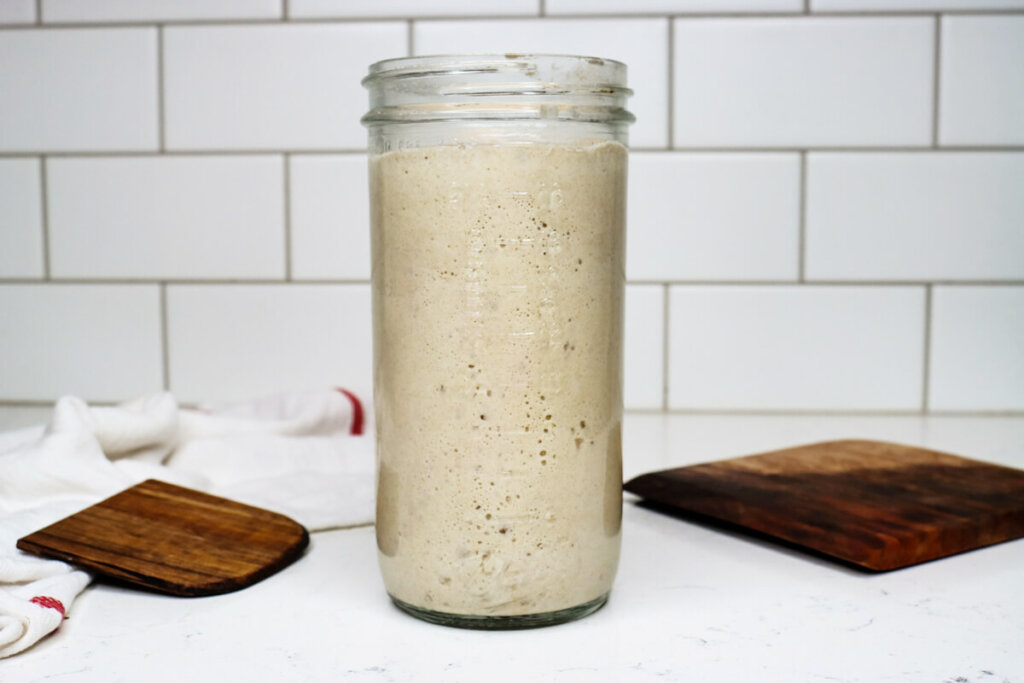
If your starter won’t take off, your loaves are dense and hard, or sourdough just flat-out overwhelms you…
👉 I’ll show you how to fix all of it.
Join my FREE live workshop and learn how to make a bubbly, active starter—the right way, from Day One.
🗓️ Jan 12 @ 1pm PT
Because these potato-filled dumplings aren’t just a staple of holiday dinners in my family, they’re a part of our heritage; A heritage full of traditions that have been passed down through generations, many of which still find a place on our dinner table at every special occasion (and many meals in between).
Perogies are a versatile food, great for both holiday dinners and midweek meals alike, much like this traditional borscht recipe. They’re also super frugal, costing mere pennies a piece when made from scratch. And a single batch will easily feed a large family (or a small village).
They make a fantastic main course as well as a perfect side dish. They stick to your ribs despite having no meat, and they’re pleasing to just about everyone’s tastebuds. I’ve literally never met anybody who doesn’t like them.
Table of Contents[Hide][Show]
The History of the Humble Perogy
Perogies originated in Eastern Europe out of necessity. They were originally considered a peasant food as they are composed of humble ingredients like flour, potatoes and onions. Nevertheless, they were a frugal way to fill hungry bellies with a few simple ingredients and helped stave off hunger during frigid and barren Eastern European winters.
Today they are enjoyed by all, regardless of class or social status, and they remain a staple food for Eastern European families like mine, even though we’ve lived in North America for multiple generations.
Food is one of those things that connects us to our past and to our ancestors and to the ways of life of long ago. Although I’m fourth generation Canadian, the perogies I make and feed my family have changed very little from those my great-great-grandmother fed to hers.
A Frugal and Filling Addition to Your Family Table
Many people are familiar with perogies, but unfortunately they don’t know much more than the fact that you can buy them pre-made from the store. I often meet people who tell me they love perogies but have never made them from scratch (and probably never even tasted them from scratch). And yet, these are one of the easiest things to make at home!
They do tend to be a little time-consuming as you typically roll out enough dough at one time to make anywhere from 50 to 150 perogies at once. But the process is straightforward and a few simple ingredients go a very long way, making this an easy pierogi recipe.
Pierogi filling recipe
- 5 lb. bag of potatoes
- 1 lb. of sharp cheddar cheese (optional)
- 1 large onion
- a pinch of salt
- pat of butter
With these ingredients you can make a batch of about 150-200 pierogis, depending on how large you’re cutting them. Now, it’s been a while since we bought them from the store (yes, it’s happened), but I think you get around the same amount or a little less in a large box from Costco and that will run you around $10.00 plus tax.
Store-bought perogies also contain added, unwanted ingredients like the food additive soy lecithin that you won’t find in this homemade version.
If you’re making them with cheese (which I highly recommend), the cheese will probably be the most expensive part of this recipe. We bought a 1-lb. brick of cheese for $6.50 and a 5-lb. bag of russet potatoes for $2.50. Add in an onion, a couple eggs and some flour and salt from our pantry, as well as a little butter and oil, and our last batch probably cost around $10 or $11.
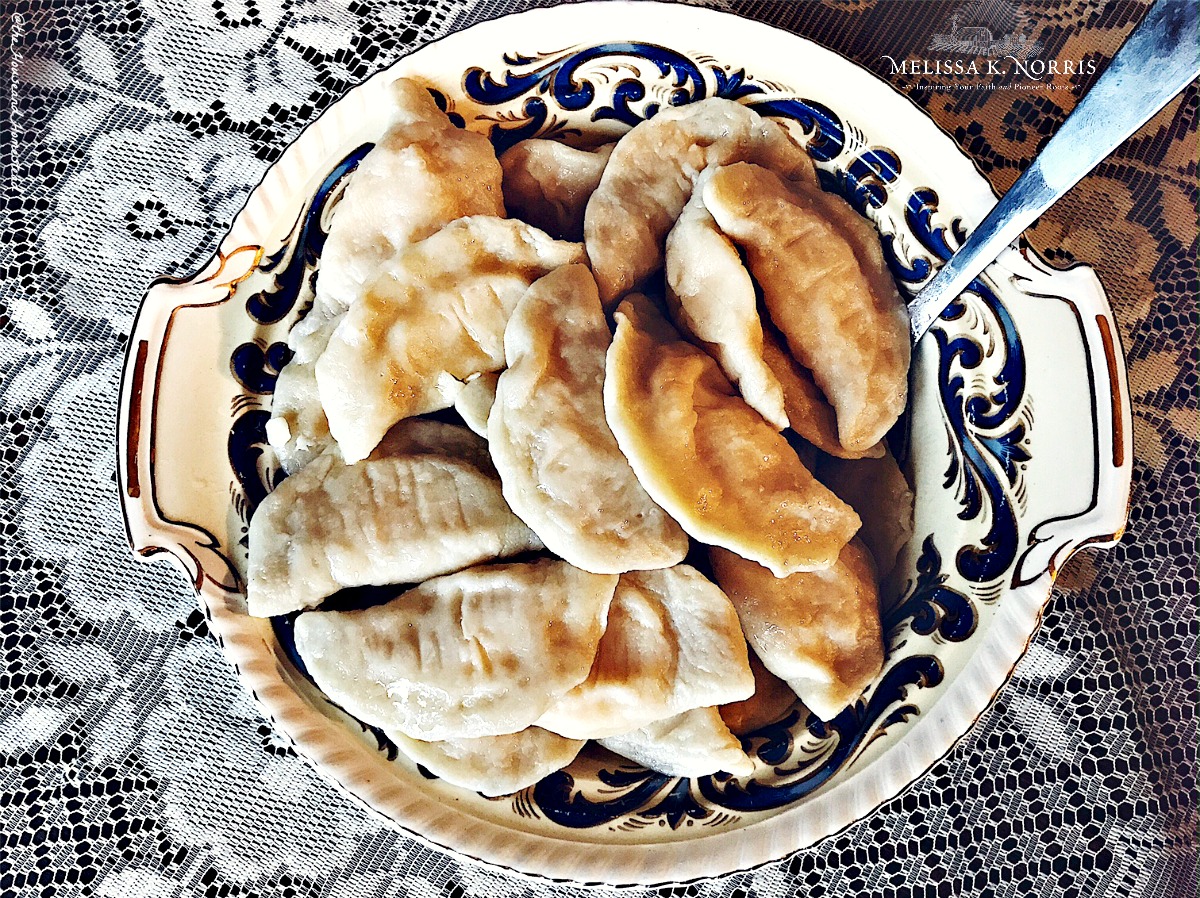
While this is roughly the same as the store-bought Costco version, it contains no questionable ingredients, the cheese is real (not processed) and you could essentially cut your costs to under $5.00 for the whole batch if you omit the cheese. For a batch of 150, this works out to just over 0.03¢ per perogy! Even with the cheese it still works out to around 0.07¢ per perogy. Now if that ain’t frugal I don’t know what is.
Subscribe to Melissa K. Norris!
Get updates on the latest posts and more from Melissa K. Norris straight to your inbox.
We use your personal data for interest-based advertising, as outlined in our Privacy Notice.
My Family’s Pierogi Main Dish Recipe
This perogy recipe was passed down to me from my aunt, who inherited it from her mother who learned it from her mother and so on. Every year around this time we begin making dozens and dozens of these little dumplings to serve at Christmas dinner as well as for Ukrainian Christmas in January and then for Malanka (Ukrainian New Year).
Traditionally, the women and girls of the family would get together to make a huge batch of perogies together. I highly recommend making this a family affair if you can!
For one, many hands make light work. But more importantly, this is such a fun tradition and is something that all generations can do together. And nothing says the males in the family can’t help out too. In fact, my husband enjoys a good perogy session just as much as I do:)
Old-Fashioned Cooking for a Busy Home
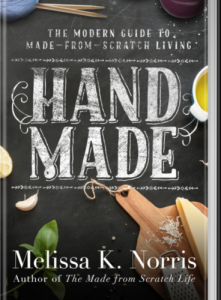
Tired of hectic meal times and complicated recipes or relying on processed foods? Instead, learn how to have
- Simple and easy time tested from scratch meals.
- Easy skillet suppers
- Nourishing and kid-approved soups and stews
- Old-fashioned baked goods from buttermilk pie, homemade cake mixes, to Mom’s chocolate chip cookies
- Don’t spend all day in the kitchen, tips for busy times without sacrificing hand made goodies
- Wholesome ingredients without processed and questionable items
Want more easy homemade recipes all in one place? This recipe and 100+ more are found in my book–-> click here Hand Made: the Modern Guide to Made-from-Scratch Living.
How to Make Perogi Potato and Cheese Filling
First you’ll want to prepare the ingredients for your filling. Start by peeling your potatoes, then cut them into quarters and boil them until soft enough to mash. While the potatoes are cooking, grate your cheese and then dice up one whole onion and sauté in a little butter.
Once the potatoes are ready to mash, strain the water out but reserve 2 cups to make your dough with. You can use regular water but using the starchy potato water makes for great dough and makes this recipe even more frugal.
Return strained potatoes to the pot. Add grated cheddar and sautéed onion and mash really well. You want the filling to be thick and firm (so don’t add any milk or cream like you might with regular mashed potatoes). But you also want to make sure there are no lumps, so mash well.
How to Make Perogies
Prepare your dough. This perogies recipe will make about 150-200 depending on how big you cut them, but you can easily multiply or divide this recipe to suit your needs.
How to Make Pierogi Dough
- Mix together flour and salt.
- In another bowl, mix a little oil with a couple eggs and the potato water (or regular water if you accidentally dumped your potato water down the drain).
- Slowly add wet ingredients to dry and mix well.
- Flour your hands and knead your dough ball until smooth.
- Then let it rest, covered, for about half an hour.
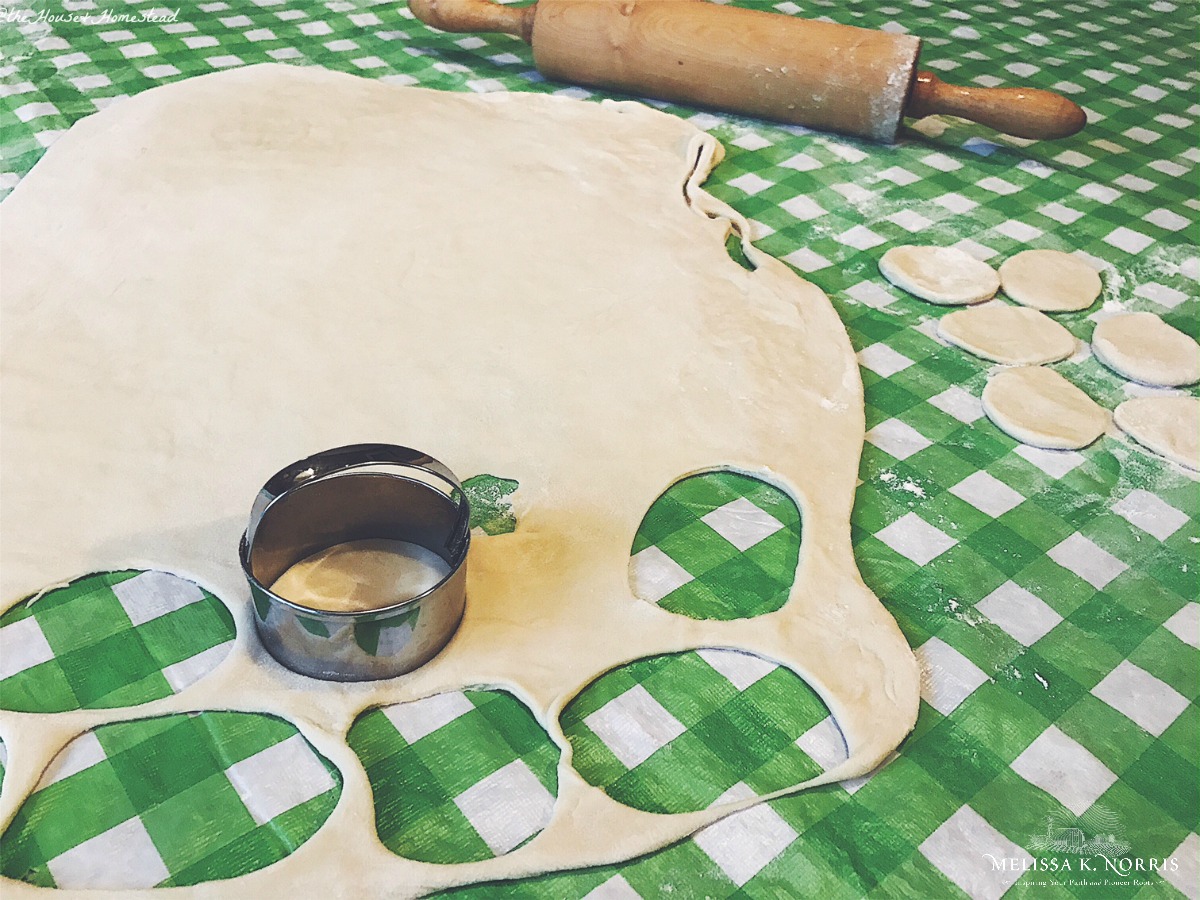
When perogie dough is ready, roll it out to about 1/8 of an inch thick. You want it thin, but be careful not to roll it too thin as it could break.
Either use a biscuit cutter or an upside-down cup to cut your circles out. Cut out as many as you can and then ball up remaining dough and roll out once more. Repeat the process until all of the dough has been used up.
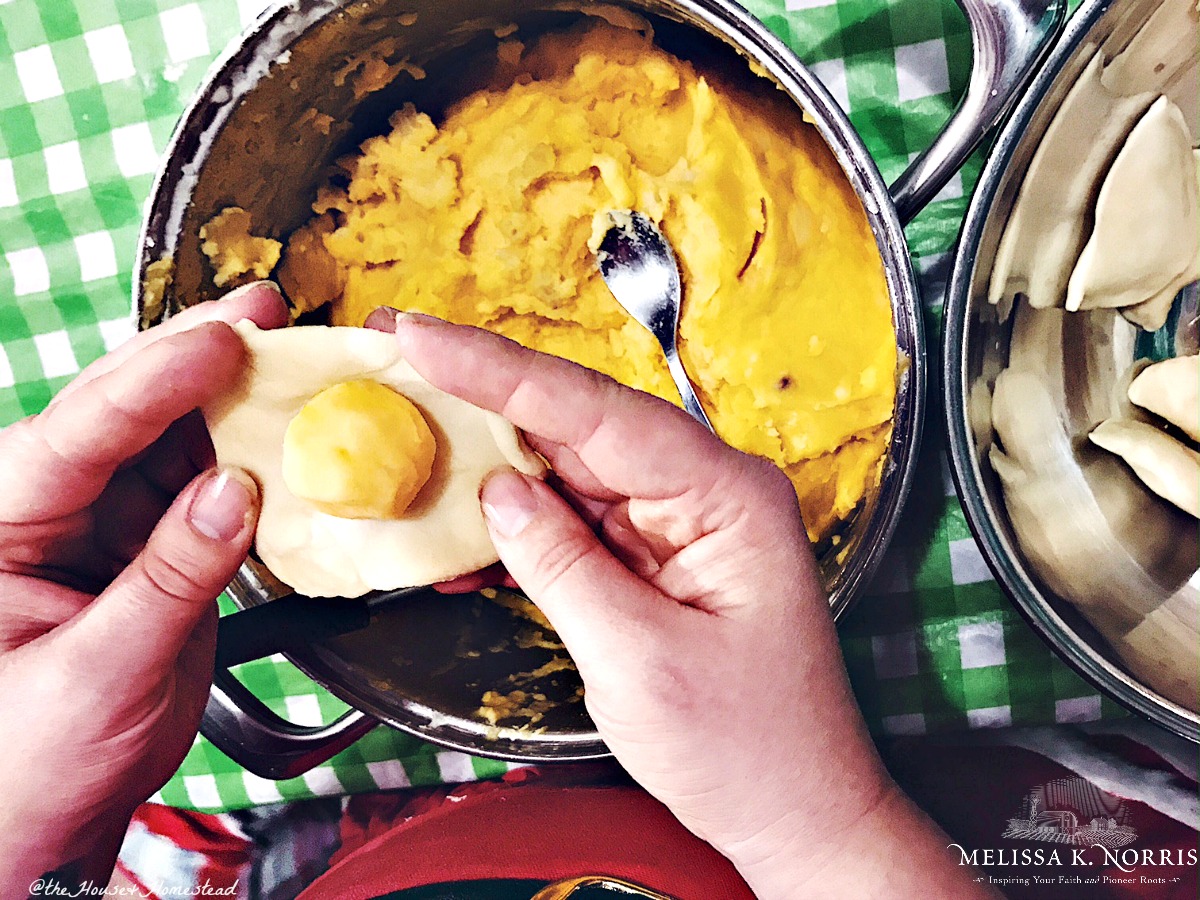
By this time, your perogi filling will be cool enough to touch. Scoop about a tablespoon of potato filling for each dumpling and roll into a neat little ball. It’s easiest if you prepare a bunch of these balls before you start filling your perogies.
Gently stretch out each circle of dough and then place a ball of filling in the centre of each one. Seal them up with your fingers as you go, pressing the two edges firmly together. Wet your fingers a little if needed to help stick the edges together.
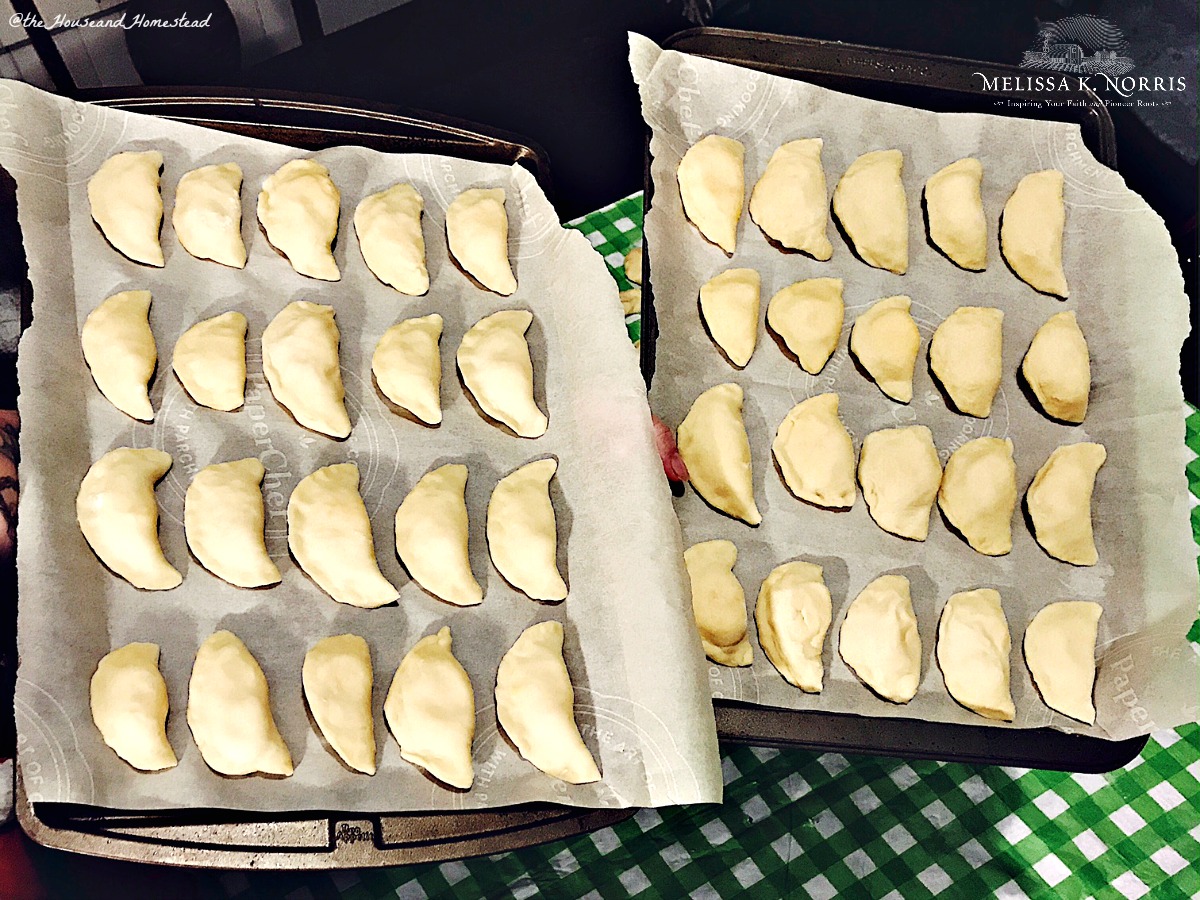
Be careful not to get any filling between the dough as this can prevent a proper seal. If your perogy dumplings aren’t sealed well the filling could boil out when you cook them. The dough is still quite edible (and yummy with sour cream!). But let’s face it; A perogy ain’t a perogy without the filling.
Repeat this process over and over until you’ve filled and sealed all your perogies. Lay each finished perogy on a baking sheet lined with parchment paper so they don’t stick together. Double check each one to make sure they’ve sealed all the way around.
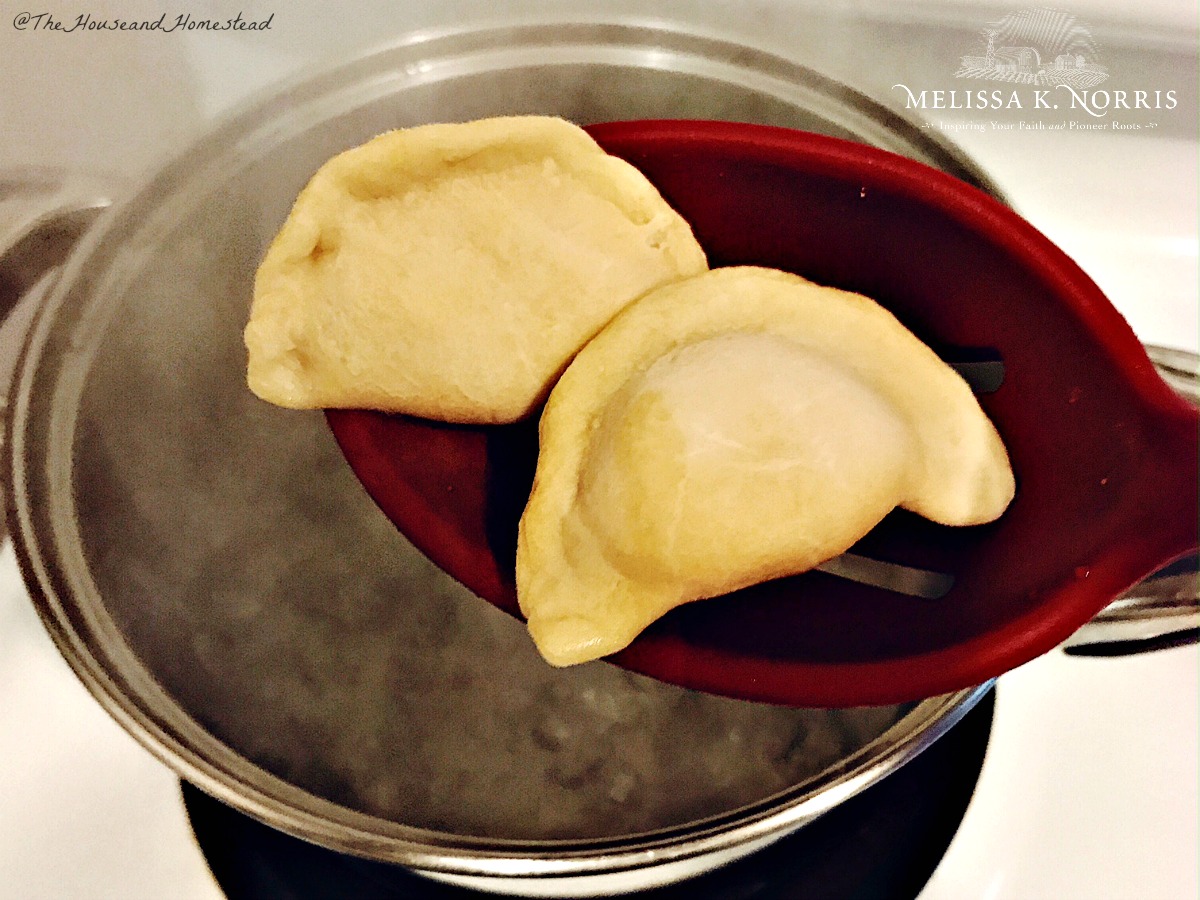
To cook, bring a pot of water to a boil and cook in small batches (no more than 10-15 perogies at a time for best results). Cooking them in small batches keeps them from sticking together as much. Stir them gently to keep them from sticking as well. Boil until done. Perogies will float to the top of the pot when they’re finished.
For best results (and to prevent them from breaking), use a slotted spoon to remove perogies from water and transfer to a colander to let drain more. Toss each batch with about a tablespoon of butter (again to prevent sticking… and because… butter).
Repeat until all perogies are cooked and then transfer to a serving dish. Serve with fried onions and sour cream, and enjoy alongside sauerkraut, cabbage rolls, pickles and Ukrainian or Polish sausage with a little mustard and you’ve got yourself a meal that’s fit for a king, but on a peasant’s budget.
Homemade Frozen Pierogies
Now, what to do with them all? Perogies freeze really well, so if you’re not planning on cooking them all the same night, put the baking trays in the freezer to flash freeze them before transferring them to a freezer bag. They should keep in the freezer for up to 4-6months.
Other Creative Fillings and Meal Ideas
Once you’ve A) used up all your dough or B) used up all of your filling, you’re finished your batch! But don’t worry about having leftover dough or filling. You can add an egg to the potato filling and form into balls, then roll in bread crumbs and fry to make potato croquettes.
And if you have extra dough, you can fill them with a variety of other ingredients to make different types of perogies. Pierogi dinner ideas with other popular fillings are sauerkraut and bacon, cottage cheese, ground or shredded meat or fruit fillings like cherry and blueberry.
You can really put anything you like in the middle. This is just a dumpling after all. You could even just cook the dough on it’s own and serve dumplings with chicken or in soup. Get creative with whatever you have on hand! Just be sure to cook any meat before using it as filling.
Share with loved ones and enjoy!
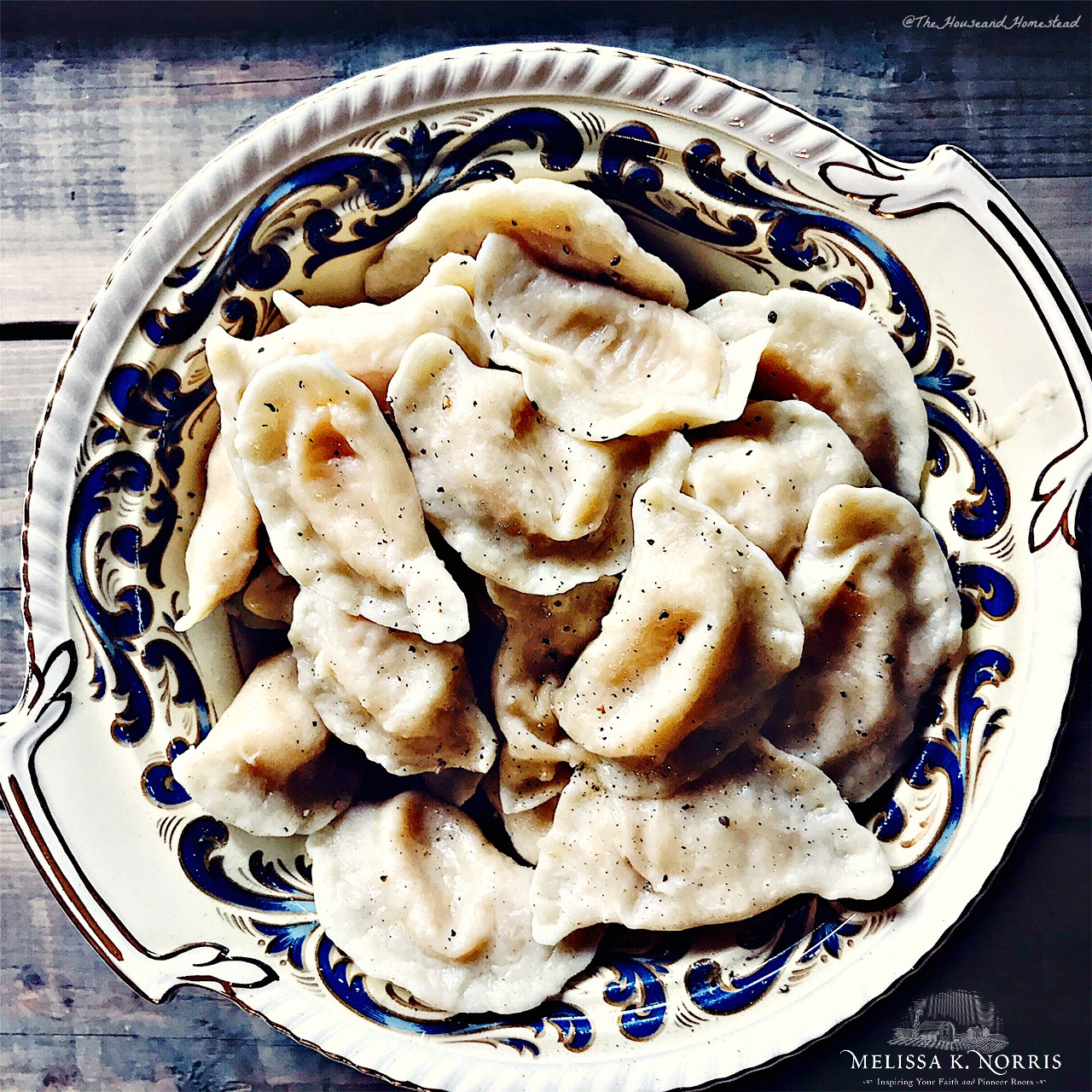
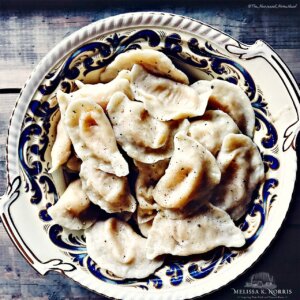
Traditional Ukrainian Perogies
Ingredients
For the Filling:
- 5 lbs russet potatoes
- 1 lb brick of old/sharp cheddar cheese grated
- 1 onion finely chopped and sautéed in butter
For the Dough:
- 6 cups all purpose flour
- 2 tsps salt
- 2 cups warm water potato water from filling is the best
- 2 Tbsp vegetable oil
- 2 large eggs lightly beaten
Instructions
- Peel potatoes and cut into quarters. Cook in boiling water until soft enough to mash.
- Drain well, reserving 2 cups of potato water for dough.
- Return potatoes to the pot and add grated cheese and sautéed onion. Mash until smooth. Let filling cool while making the dough.
- In a large bowl, sift flour and combine with salt.
- Mix together water, oil and egg, and pour half of mixture into flour. Mix and slowly add the remaining liquid. Knead by hand until flour and liquid are well combined, into an elastic ball. You may need to add a small amount of either flour or water, depending on the consistency of the dough.
- When well blended and smooth, wrap in plastic wrap or a clean plastic bag and let dough rest for at least 30 minutes.
- Cut dough in half or in thirds, keeping unused dough well wrapped in plastic until needed. Flour the table or counter lightly and roll dough to about 1/8 inch thickness (thin is best, but not too thin, as you don’t want the dough to break as you fill your perogy).
- Cut the dough in rounds using a biscuit cutter or a small drinking glass (upside down).
- Scoop about 1 Tbsp of potato filling for each perogy and roll into a ball in the palms of your hands.
- Fill each round of dough with a ball of potato filling and seal the edges of the dough together with your fingers. Make sure when pinching the edges to ensure there are no gaps or that the 2 sides of the dough do not pull away from each other. Wet you fingers just a little if needed to help dough stick together.
- Freeze on a baking tray and then transfer to a freezer bag if making in advance.
- To cook, bring a pot of water to a boil and cook in small batches (10-15 perogies at a time), stirring gently to prevent dumplings from sticking together. Perogies are finished cooking when they float to the top.
- Use a slotted spoon to remove them from water and drain before transferring to a serving bowl. Toss with butter and serve hot with sour cream. Add fried onions and.or bacon bits to take your perogies to the next level!
There you have it, how to make perogies at home. Will you be making this treat any time soon?
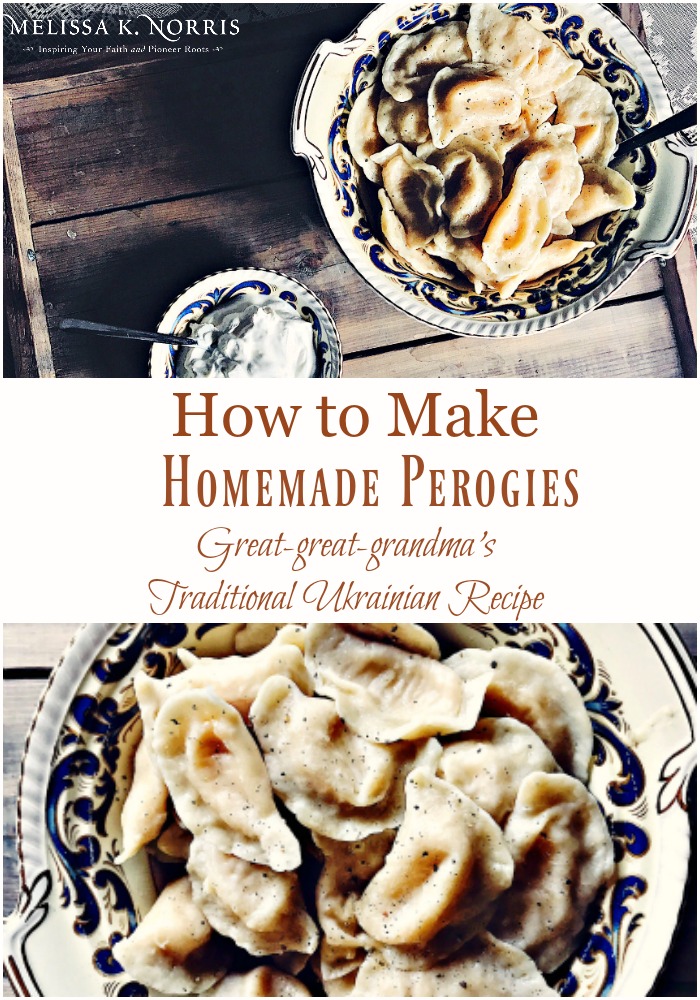


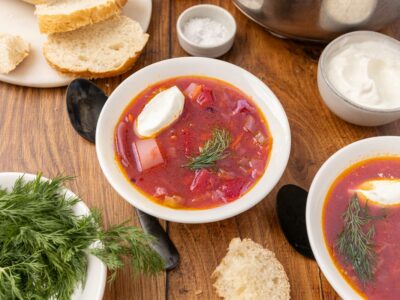
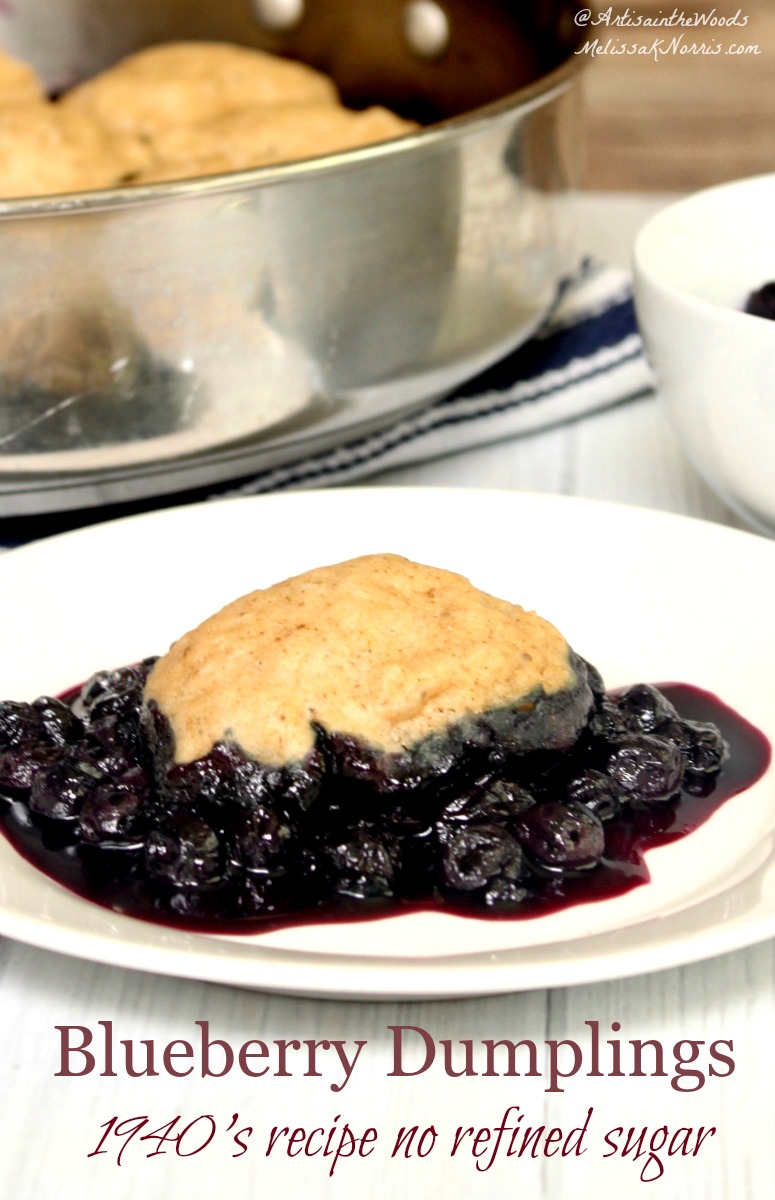







Can you use Cooper Sharp cheese instead of cheddar cheese
I don’t want to seem mean, but pierogi is already plural. You don’t need to add ‘es’. Just an FYI 🙂
This is so good, Thanks so much, Melissa, for giving a really nice and simple recipe!
Your story was beautiful and your recipe for “Ukrainian” pierogi is perfect. Thank you so very much for sharing this moment into my childhood.
I can’t wait to try this recipe. I’m of German decent and my Aunts used to talk about having dumplings almost at every meal. They weren’t perogies however, but stretched the meals for a large family none the less. I had a Russian student a few years ago who brought in perogies that his mother made.They were absolutely delicious. She would make huge batches and sell them in the community. It sounds like your recipe is a good one and I can’t wait to try to make it. It is just my husband and I now so I hope that these will freeze well. Should they be blanched before freezing or put straight into the freezer for longer storage? Thanks for sharing your recipe and the traditional family history behind it!
Once you have them made, put the whole uncooked pan in the freezer and freeze them. Then put them in a ziplock baggie. They should last 4 to 6 months.
I am curious as to whether these would dehydrate well and so keep if they could not immediately be cooked.
My great-grandmother would stuff a single perogy with a balled up facial tissue (clean!) instead of potato as a prank.
If you ended up biting into that perogy, you would get a special gift as consolation.
I love her sense of humor!
I love this recipe! For years I was afraid to try, so thank you. I’m still troubleshooting the filling. I’ve run out of dough, made another 1/2 batch, and still have filling leftover. It’s ok, we make mashed potato pancakes with it.
I am going to make these, from your recipe. I would like to know if you have to boil them before you freeze them. Making them to send to family members, would it be better not to boil before freezing them. Thank you. Have a nice Thanksgiving.
Years ago I had a friend who was Ukrainian. When she came to visit me she asked if I wanted her to make me some perogies. Of course I said yes! The ingredients are so simple, I had everything on hand. She had me prepare the filling while she made the dough. She didn’t measure anything and didn’t use a bowl. She put handfuls of flour on my old enamel kitchen table, made a little well in the flour, put the eggs in there, and with her fingers, worked the eggs into the dough. Then she adjusted the texture with some sprinkles of water. I was amazed watching her do all of this and in a matter of minutes. We were both in our early 20s but she was so familiar with making perogies, for her it was like making toast. She kept adding more flour while she rolled out the dough on the table, cut the dough with a knife, and we put the fillings in together. I have eaten lots of perogies since then but none as good as those. I will make the ones from your recipe, but none will ever be as good as those perogies my friend made on my kitchen table. 🙂
I dont see ingredient amounts/measurements for making the dough… All I see is add flour, salt etc. Where to find measurements for making dough? Thanks!
It’s listed in the printable recipe card at the bottom of the post ?
This looks like a great recipe, and I’d love to try it. I can’t find the amount of flour used to prepare the dough, however. Am I missing it somewhere? Thanks!
In the printable recipe card it’s the first ingredient under the dough, 6 cups
Thanks for the perogies recipes. Although in the UK we have many nationalities there doesn’t seem to be many recipe books with this type of food, so it’s really nice when people put out traditional recipes online. can’t wait to give them a go!One stew recipe that I make is really nice, it’s what I call ‘chuck it in stew’, literally anything you have gets chucked in.
Hello all; Im 60 and as far back as I can remember the perogie was a main stay in the winter months . I began helping @ about 5 years old growing up in a home where Ukrainian was spoken as much as English its no wonder . Well in making a few different distinctions the cheese we always used Long horn and the onions were always cooking in a couple pounds of butter . The dough was made with a one to one ratio of egg to flour and salted water was added if needed . As soon as perogies came out of the water we added a heaping spoon of those delicious camelized onions and dug in . Normally made 200 or 300 but they didn’t last a whole week . When they cool that’s when you fry them and they get an even different dimension don’t forget the sour cream and lots of it .. Live a little eat work hard and splurge !!!
my husband just got done making 100+ meat things (perogy) and 100 cheese things (Perogy) they are for zmas. his mother taught him. but he does not knoe if they are polish or ukrainian. we have them every year. I being irish can not help him.
Thank you so much for sharing your perogies recipe! My husband is Polish and wistfully talks of his mothers’ perogies which I unfortunately, never got to try. I can’t wait to make them as a surprise for him!
I love pierogies, I an American Polish and I had made these and I may make the again.
Can this be made with an all purpose gluten free flour ?
I have never tried making them with gluten free flour. (I dare not utter the words “gluten free” in a Ukrainian family). But I would think they would work just fine as long as the dough sticks together when you pinch the edges together. If you try them gluten free please let me know how they turn out! I’d love to know!
I haven’t had these in years and would love to try and make some homemade. I had a sudden onset allergy to eggs-my farm fresh ones 🙁 Do you think the dough would work without the eggs? Thank you in advance 🙂
Yes it will work without eggs, but the dough will be very tender and fragile. You might need to none stick your hands first.
For Christmas Eve, my mother never used eggs because of fasting. Use oil in place of eggs. Tender and still delicious.
I have made gluten free using the one to one flour. The hardest part is rolling it out. They stick together fine with a little water on the edges. They tasted great according to my daughter and grandson who both have celiac.
My husband lives pierogies (his family was Belarusian & Ukrainian). I’ve never tried making them before but this sounds doable. Thanks!
If you make them, let us know how they turn out!
It is totally doable! It’s actually quite easy and they seriously do freeze so well that you can pop them in the freeezer and then just throw them in a pot when you’re ready to cook them just like store-bought ones. One of my favourite things about preserving food is the convenience factor when you’re ready to cook and these perogies deliver on that for sure!
I love Pierogies, I am American Polish and have made them in the past but I will use this recipe.